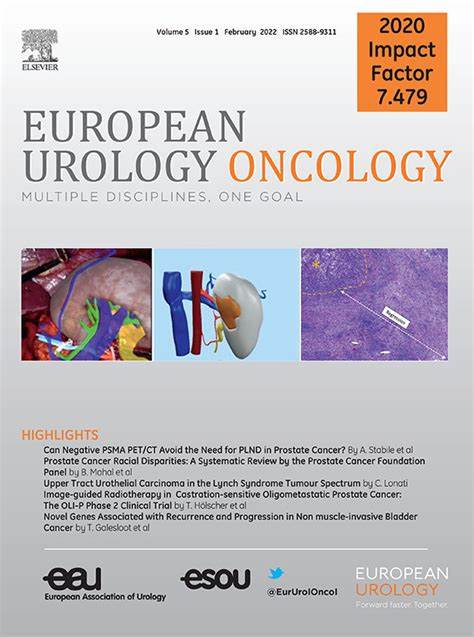Prostate-specific Antigen Nadir and Cancer-Control Outcomes in Real-world Apalutamide-treated Metastatic Hormone-Sensitive Prostate Cancer Patients: A Single-Center Analysis
IF 8.3
1区 医学
Q1 ONCOLOGY
引用次数: 0
Abstract
Background and objective
Currently available post hoc phase 3 trial–derived data suggest better cancer-control outcomes in apalutamide-treated metastatic hormone-sensitive prostate cancer (mHSPC) patients achieving an (ultra)low prostate-specific antigen (PSA) nadir. This study aims to validate ultralow PSA nadir cutoffs.
Methods
Relying on an institutional prostate cancer database, 107 eligible patients were yielded. The currently available PSA nadir cutoffs (SWOG trial: <0.2 ng/ml; ultralow TITAN trial: ≤0.02 vs 0.02–0.2 vs >0.2 ng/ml) and PSA responses (≥99%) were tested for time to castration-resistant prostate cancer (ttCRPC) and overall survival (OS) in mHSPC patients treated with apalutamide. Finally, comparisons were made against abiraterone mHSPC treatment.
Key findings and limitations
Overall, 107 mHSPC patients treated with apalutamide at a median age of 68 yr and baseline PSA of 29 ng/ml were included. The highest proportion of included patients (40.2%) achieved an ultralow PSA nadir of ≤0.02 ng/ml. Patients reaching the SWOG 9346–defined PSA nadir of <0.2 ng/ml and ultralow PSA nadir of ≤0.02 ng/ml harbored the longest time to metastatic castration-resistant prostate cancer (mCRPC) and OS (all p < 0.05). Moreover, 80% of mHSPC patients treated with apalutamide achieved a PSA response of ≥99%. These patients also harbored better time to mCRPC and OS outcomes, relative to patients with a <99% PSA response (both p < 0.05). In the second step of analyses, a comparison against abiraterone patients showed a significantly higher rate of achieving an ultralow PSA nadir of ≤0.02 ng/ml: 40.2% versus 8.8% for apalutamide versus abiraterone, resulting in a significantly longer ttCRPC for the apalutamide-treated (37 mo) than for the abiraterone-treated (22 mo) group (p = 0.001), even after multivariable adjustment and in sensitivity analyses for high-risk mHSPC patients only. The study is limited by its retrospective design.
Conclusions and clinical implications
In the real-world setting, most mHSPC patients treated with apalutamide achieve an ultralow PSA nadir, which is associated with better cancer-control outcomes. Moreover, a PSA response of ≥99% predicts better outcomes. In head-to-head comparisons, apalutamide achieves better PSA kinetics and ttCRPC outcomes than abiraterone.
Patient summary
A prostate-specific antigen (PSA) nadir of <0.02 ng/ml and PSA responses ≥99% are associated with better cancer-control outcomes in metastatic hormone-sensitive prostate cancer patients treated with apalutamide.
阿帕鲁胺治疗的转移性激素敏感性前列腺癌患者的前列腺特异性抗原 Nadir 和癌症控制结果:单中心分析
背景和目的:目前可用的 3 期试验后数据表明,阿帕鲁胺治疗的转移性激素敏感性前列腺癌(mHSPC)患者达到(超)低前列腺特异性抗原(PSA)萌芽状态时,癌症控制效果更好。本研究旨在验证超低 PSA nadir 临界值:方法:依托机构前列腺癌数据库,筛选出 107 名符合条件的患者。对目前可用的 PSA nadir 临界值(SWOG 试验:0.2 纳克/毫升)和 PSA 反应(≥99%)进行了测试,以确定接受阿帕鲁胺治疗的 mHSPC 患者发生阉割耐药前列腺癌(ttCRPC)的时间和总生存期(OS)。最后,与阿比特龙mHSPC治疗进行了比较:总共纳入了107名接受阿帕鲁胺治疗的mHSPC患者,他们的中位年龄为68岁,基线PSA为29纳克/毫升。入选患者中达到 PSA 最低值≤0.02 ng/ml 的超低 PSA 患者比例最高(40.2%)。结论和临床意义:在现实世界中,大多数接受阿帕鲁胺治疗的 mHSPC 患者都能达到 PSA 的超低临界值,这与更好的癌症控制结果有关。此外,PSA反应≥99%也预示着更好的治疗效果。在头对头比较中,阿帕鲁胺的 PSA 动力学和 ttCRPC 治疗效果优于阿比特龙。
本文章由计算机程序翻译,如有差异,请以英文原文为准。
求助全文
约1分钟内获得全文
求助全文
来源期刊

European urology oncology
Multiple-
CiteScore
15.50
自引率
2.40%
发文量
128
审稿时长
20 days
期刊介绍:
Journal Name: European Urology Oncology
Affiliation: Official Journal of the European Association of Urology
Focus:
First official publication of the EAU fully devoted to the study of genitourinary malignancies
Aims to deliver high-quality research
Content:
Includes original articles, opinion piece editorials, and invited reviews
Covers clinical, basic, and translational research
Publication Frequency: Six times a year in electronic format
 求助内容:
求助内容: 应助结果提醒方式:
应助结果提醒方式:


